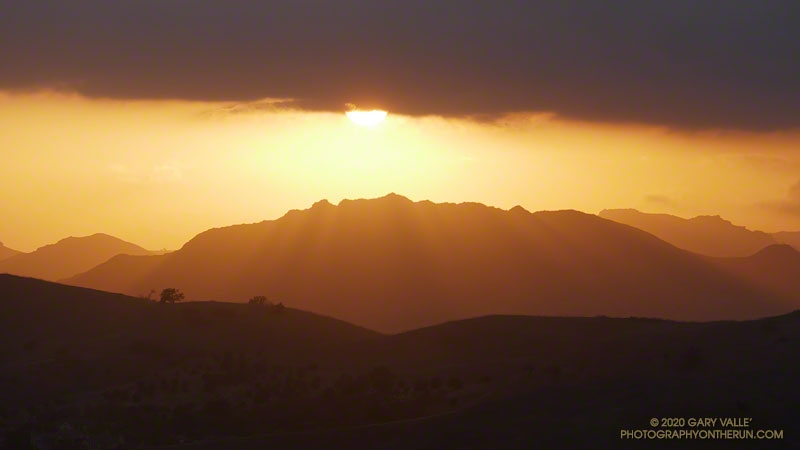
The photograph of Ladyface and the setting sun was taken from Lasky Mesa during an afternoon run in Upper Las Virgenes Canyon Open Space Preserve (Ahmanson Ranch).
Related post: Longer Late Afternoon Runs

The photograph of Ladyface and the setting sun was taken from Lasky Mesa during an afternoon run in Upper Las Virgenes Canyon Open Space Preserve (Ahmanson Ranch).
Related post: Longer Late Afternoon Runs
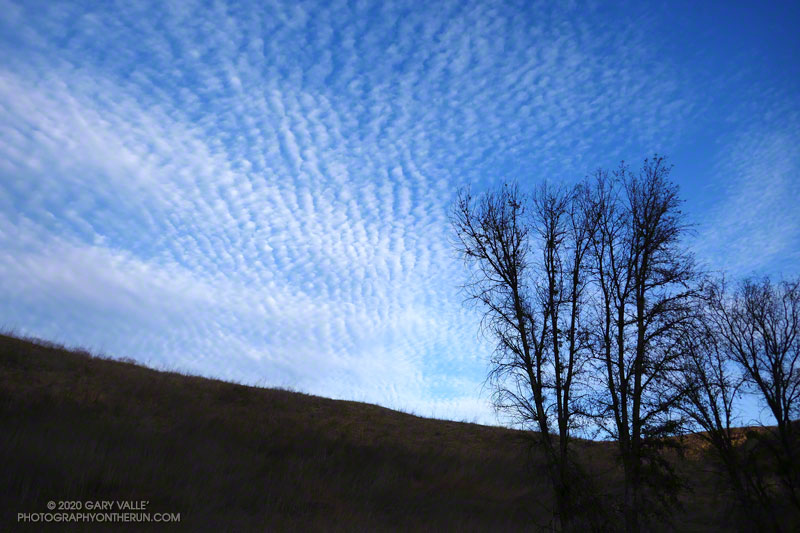
Cirrocumulus clouds form at high altitude. They are primarily composed of ice crystals but also contain supercooled water droplets.
The photograph of cirrocumulus clouds was taken in Las Virgenes Canyon on a trail run from the Victory Trailhead of Upper Las Virgenes Canyon Open Space Preserve, also known as Ahmanson Ranch.
Some related posts: Pattern Change Ahead, Fallstreak Hole, Rainbow Colors in Cirrus Clouds Over Los Angeles
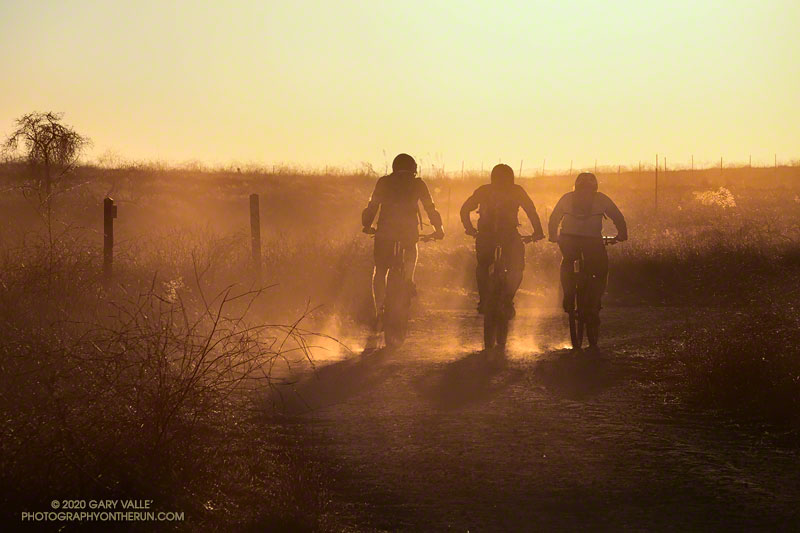
Except for a teaser storm system in early November that brought a smattering of rain to the metro area and some snow to the mountains, the Los Angeles rain year is off to a parched start.
As of December 1, Downtown Los Angeles (USC) has recorded only 0.11 inch of rain since July 1. Along with 1995, this is the 7th driest start to the rain year over the 144 years weather records have been kept in L.A.
Update December 29, 2020. In the first significant storm of the rain year, Downtown Los Angeles recorded 1.82 inch of rain, bringing the rainfall total up to 1.95 inches. The storm total was more than generally forecast, but L.A. is still about 2 inches below normal for the date. The rain does move 2020 out of contention for the driest first six months of the rain year.
Update December 20, 2020. The period July 1 – December 20, 2020 is the driest on record (for that date range) for Los Angeles. As of December 20, the rainfall total for Downtown Los Angeles (USC) remains at 0.11 inch.
While “past performance may not be indicative of future results,” I was curious to see if, historically, a dry start to the rain year has generally resulted in below average annual rainfall.
There have been 16 years in which Los Angeles precipitation was 0.25 inch or less for the period July 1 to December 1. Rain year precipitation (July 1 – June 30) for those years varied from a low of 4.79 inches in 2017, to a high of 23.43 inches in 1937. Overall, these years averaged 11.34 inches of rain annually, which is 3.66 inches below the current normal of 14.93 inches.
Whether or not annual rainfall this rain year is below normal we’ll have to see. An important consideration is that La Nina conditions are present in the equatorial Pacific. This doesn’t necessarily mean less rainfall in the Los Angeles area, but taking into account a number of factors, the Climate Prediction Center is projecting below average precipitation this Winter in Southern California.
The title photo of silhouetted mountain bikers is from this afternoon’s run at Upper Las Virgenes Canyon Open Space Preserve (Ahmanson Ranch). The image is an example of a “silhouette illusion.” Are the riders going toward or away from the camera?
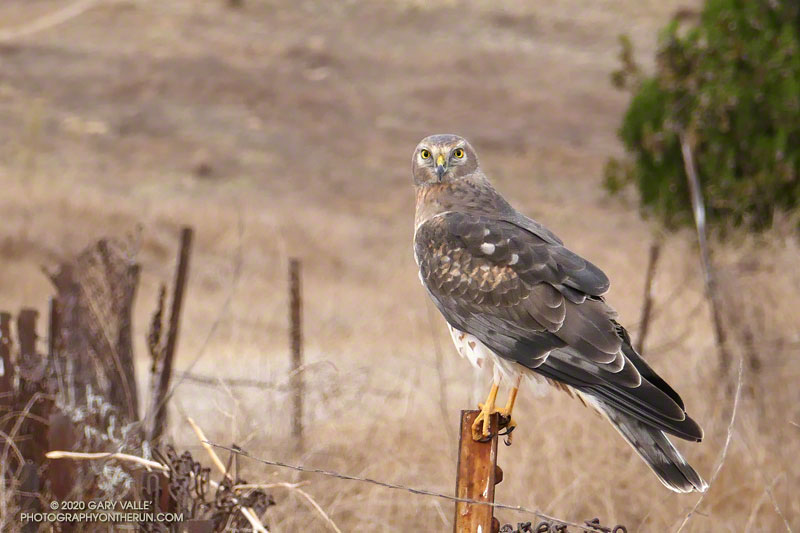
I turned the corner, and about 60 yards away, a large, gray hawk was perched on a fencepost. It looked like it might be a male northern harrier. I stopped and snapped a couple of photos. If it flew away, at least I would be able to confirm the ID.
I was running on Lasky Mesa, a unique oak and grassland area in Upper Las Virgenes Canyon Open Space Preserve. Better known as Ahmanson Ranch, the area is adjacent to West Hills, a suburb of Los Angeles. The open space park is a haven for several species of raptors, including red-tailed hawks, American kestrels, northern harriers and white-tailed kites.
In my experience, northern harriers are shy birds, and in most of my previous encounters, the birds have been on the wing. Moving closer, I walked a few steps, took a photo, walked a few more steps, then took another shot. Astonishingly, I was only about 20 yards from the bird, and it did not fly.
That’s when I heard the fast-paced footfalls of another runner approaching from behind. I held my breath and continued to photograph the harrier. Whether spooked by my presence or the approaching runner, the bird had had enough, and he finally took flight.
Northern harriers, and harriers in general, are unusual birds. They have evolved to subsist in open areas such as grasslands and marshes. Their physical features reflect the requirements of efficiently hunting in these habitats.
Northern harriers are adapted to use vision and sound to hunt their prey. Like owls, they have a facial ruff and asymmetric ears that are used to amplify and locate sounds made by prey. They also are reported to have feather adaptations for flying more quietly.
They are powerful, acrobatic birds. Their wings and tail are extraordinarily large for their body size. In aerodynamic terms, they use variable geometry to maximize lift or glide as needed. In slow flight, they can turn on a dime, leaving virtual skid marks in the sky. During strong Santa Ana winds, I’ve seen them dynamically soaring (like an albatross) on slightly-sloped Lasky Mesa.
Previously, I photographed a pair of northern harriers hunting on Lasky Mesa after sunset. It was a surreal experience to watch them in the diminishing light. They appeared to be working cooperatively, and their hunt was successful.
Some related posts: Northern Harrier Turning to Strike, Another Red-tailed Hawk Encounter, Kestrel Encounter
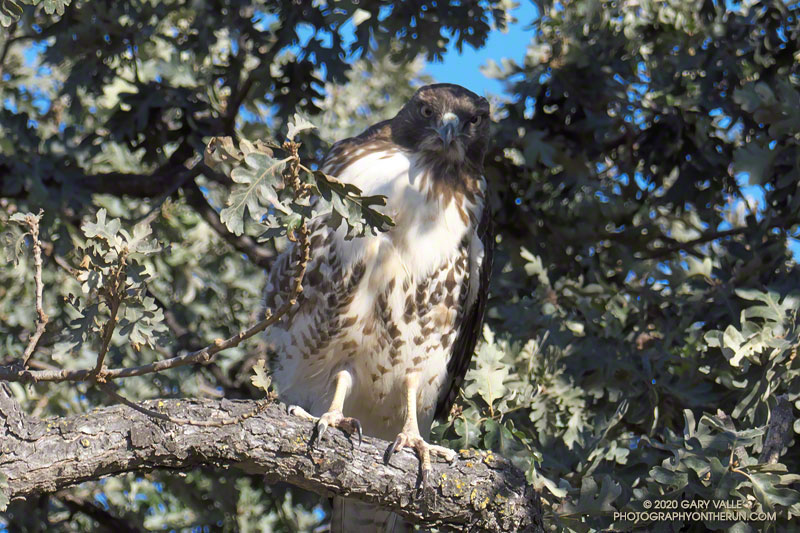
The afternoon was full of Fall. Oak leaves danced in a cool breeze, their shadows producing a familiar speckled pattern of shadow and sun, shadow and sun.
I was running northeast along the margin of Lasky Mesa in Upper Las VIrgenes Canyon Open Space Preserve, enjoying the Fall weather and smoke-free sky. I’d just passed a valley oak along the dirt road, when a thought bubbled up from my subconscious and asked, “Did you see what I saw in that tree?”
I stopped, turned around, and walked the few steps back to the oak tree.
Just feet from the road, partially camouflaged by oak leaves and shadows, was a red-tailed hawk. It seemed surprised, if not indignant, to have been discovered. I was equally astonished to have seen the bird.
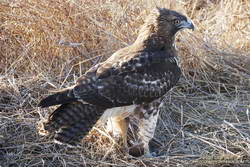
The pattern of its plumage now made perfect sense. The hawk had been nearly invisible while feet away and in plain sight. I took one more photo, and then left the bird to its reverie.
I smiled as I ran down the road, and wondered if this was the same hawk that had buzzed me in Red-tailed Hawk Encounter.
Update November 14, 2020. Was near the spot where the encounter described above occurred and photographed a red-tailed hawk with a small rodent it had just killed. Since it’s in the same area, it may be the same bird.
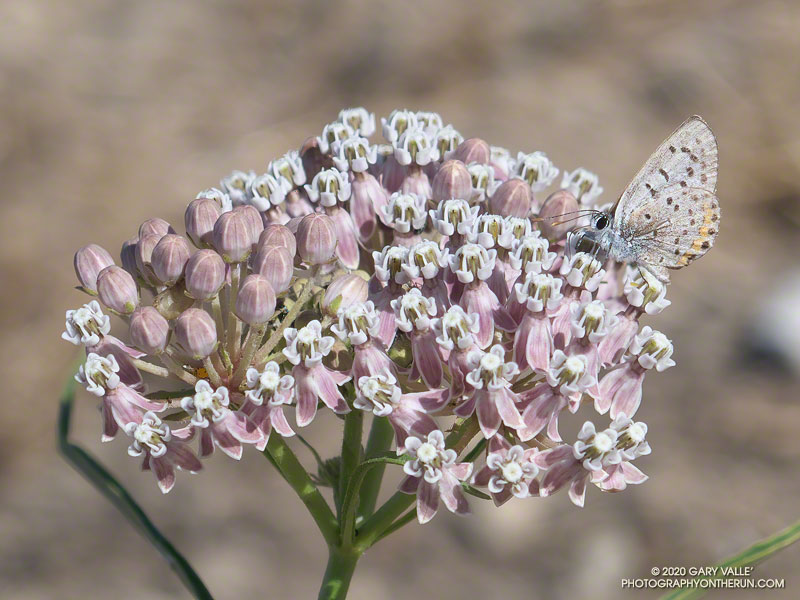
An Acmon Blue butterfly on narrow-leaved milkweed on Lasky Mesa.
From a run in Upper Las Virgenes Canyon Open Space Preserve (Ahmanson Ranch) on August 6, 2020.
Some related posts: Painted Lady Butterflies in Upper Las Virgenes Canyon Open Space Preserve, Checkerspot Along the Garapito Trail, Tiger Swallowtail on Snow Plant